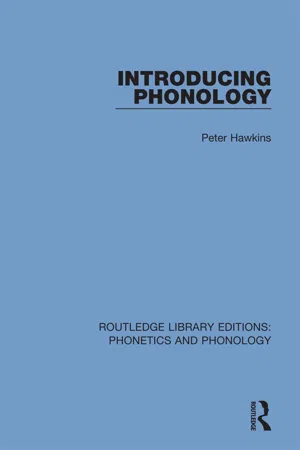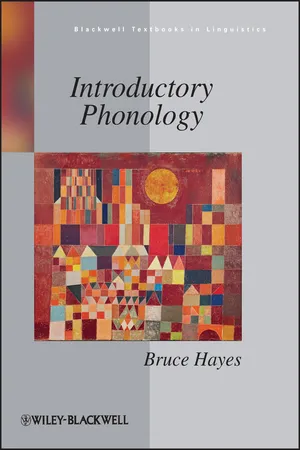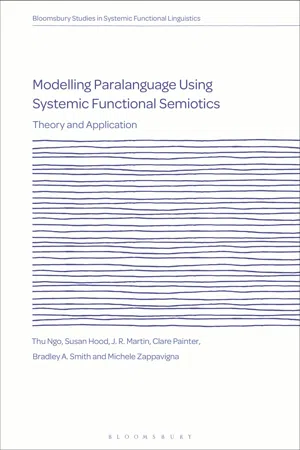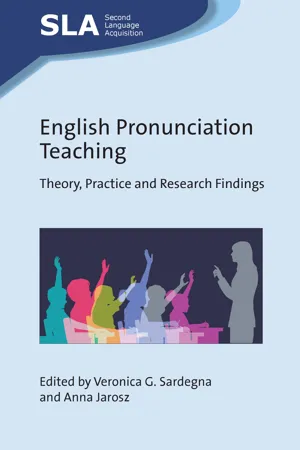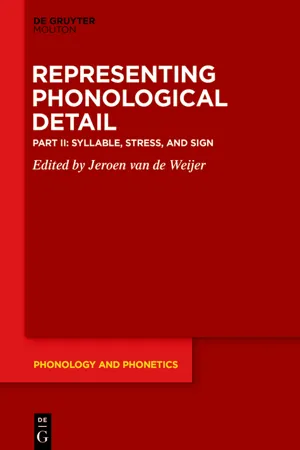Languages & Linguistics
Intonation
Intonation refers to the variation in pitch, stress, and rhythm in spoken language. It plays a crucial role in conveying meaning, attitude, and emotion in communication. Different languages and dialects have distinct intonation patterns, which can impact how messages are interpreted and understood.
Written by Perlego with AI-assistance
11 Key excerpts on "Intonation"
- eBook - ePub
- Peter Hawkins(Author)
- 2018(Publication Date)
- Routledge(Publisher)
7 IntonationIntonation is the name given to the fluctuations of pitch in spoken utterances. It normally refers to the pitch patterns of a larger grammatical unit such as a phrase, clause, or sentence, though of course a sentence may consist of only a single word, in which case Intonation can apply to it. Intonation and stress are related phenomena (see above, p. 178) and, indeed, some writers use the term ‘sentence stress’ for what we shall call Intonation.In this chapter our general aims will be: first, to present a concise, simple, yet adequate method for transcribing Intonation, i.e. a suitable notation; second, to relate the pitch patterns to typical sentence functions such as statement, question, etc.; and third, to explore the role of Intonation in grammatical structure, looking particularly at examples in which Intonation resolves grammatical ambiguity.Basic featuresIntonation has three basic properties:1 It is a language universal. There are no languages which are spoken as a monotone, i.e. without change of pitch. In ‘tone’ languages, pitch change can be used to make a difference between one lexical word and another, in the same way that /p/ and /b/ differentiate pit and bit: in Chinese, which is a good example of a tone language, lán (high rising tone) means ‘blue’, but lăn (fall-rise tone) means ‘lazy’. Non-tonal languages, like English and most other European languages, do not make such lexical distinctions. In the tone languages, however, when the individual lexical items are combined into phrases and sentences, there still emerges an overall pitch ‘contour’ which is not simply the sum of the individual (lexical) tones, but carries the same functions as Intonation in other (non-tonal) languages. So tone languages have Intonation, but in addition the tones can be used to make lexical distinctions.2 Intonation is functional, - eBook - ePub
- John A. Goldsmith, Jason Riggle, Alan C. L. Yu, John A. Goldsmith, Jason Riggle, Alan C. L. Yu(Authors)
- 2011(Publication Date)
- Wiley-Blackwell(Publisher)
Chapter 15 Intonation MARY E. BECKMAN AND JENNIFER J. VENDITTI 1 The Scope of This ChapterAs a technical term in phonological descriptions of spoken languages, Intonation refers to patterned variation in voiced source pitch that serves to contrast and to organize words and larger utterances. In this general statement of its meaning, it is synonymous with the technical term tone. In typical usage, however, the two terms are differentiated by applying them to different aspects of these linguistic uses of pitch, a differentiation that is reflected in this edition of the Handbook of Phonological Theory by the fact of there being a separate chapter on tone (Hyman, this volume). In order to delimit the scope of the present chapter,1 therefore, we begin by listing the aspects of the linguistic use of pitch that are typically invoked in differentiating Intonation from tone.The differentiation is exemplified by the two parts of the sixth definition for the entry for “tone” in the Concise Oxford English Dictionary (eleventh edition): “(in some languages, such as Chinese) a particular pitch pattern on a syllable used to make semantic distinctions” and “(in some languages, such as English) Intonation on a word or phrase used to add functional meaning.” This sixth definition is tagged as the meanings for a technical term in phonetics, and its second part subsumes the term “Intonation,” which is defined in its own entry as “the rise and fall of the voice in speaking.” In the COED entry, then, the primary sense of tone as a technical term in describing sound patterns refers to a localized melodic event (a note or glissando) occurring over the span of a syllable, whereas tone qua Intonation refers to a pattern of glissandi distributed over a longer span. Also, tone in this primary sense invokes a system of contrastive pitch patterns that act as minimal word-differentiating elements, comparable to the inventory of vowels or consonants of a language, whereas tone qua - eBook - ePub
Children's Intonation
A Framework for Practice and Research
- Bill Wells, Joy Stackhouse(Authors)
- 2015(Publication Date)
- Wiley-Blackwell(Publisher)
While the phonetic approach is concerned with the accurate description of prosodic parameters in speech, using auditory perceptual and instrumental techniques, the linguistic approach to Intonation shows how these features communicate meaning. Prosodic features serve to realize linguistic systems such as tone (in tone languages), stress and Intonation. From this perspective a prosodic impairment impacts on the linguistic system in question, with the result that the speaker’s meaning, in its broadest sense, may be obscured. Identification of a linguistic impairment of Intonation is therefore dependent on the analyst having a description of the Intonation system of the language. The Intonation of English has probably received more scholarly attention than that of any other language, though systematic descriptions are now available for a large number of different languages (Hirst & Di Cristo, 1998; Jun, 2005).Various approaches to the systematic description of Intonation have been adopted. The ToBI notation, derived from autosegmental-metrical theory, has been widely adopted in phonetic and speech technology research (Jun, 2005; Ladd, 2008). However, it has so far been little applied to clinical analysis or to studies of children’s Intonation development, where versions of more traditional analyses have tended to be used, following the lead of David Crystal (Crystal, 1987; Snow & Balog, 2002). As a necessary foundation for the rest of the book, the next part of this chapter provides a descriptive framework for English Intonation, based on this more traditional approach.English Intonation: a brief introduction
The term Intonation is generally used to refer to the linguistic patterning of pitch height and movement, together with loudness and duration, to realize meanings that are additional to the meanings conveyed by words and grammar. When pitch is used in lexical and/or morphological systems, for example, to distinguish word meanings, we talk of a tone language. Well-known examples include Thai and Mandarin Chinese, which will be discussed in Chapter 6 - eBook - ePub
- Gillian Brown(Author)
- 2017(Publication Date)
- Routledge(Publisher)
5 The function of IntonationThere have been three major traditions in describing the functions of Intonation in English. One has largely associated Intonation with the expression of attitudes—the 'it's not so much what he said but the way he said it' approach (exemplified, for instance, in O'Connor and Arnold, 1961). One has been largely concerned with relating Intonation to syntactic structures (see, for instance Crystal, 1969). The third has been concerned to relate Intonation to the speaker's desire to signal to the listener how to treat the information contained in the utterance—a view deriving from work in the Prague School brought to the attention of western scholars most notably by Halliday (see, for instance, Halliday, 1970) and developed recently by Brazil, Coulthard and Johns (1980). 1 shall leave the discussion of the expression of attitudes until Chapter 6 , and concentrate in this chapter on a view which unites the second and third traditions in this sense: it assumes that the speaker does indeed signal to the listener how to take the information contained in the utterance and that one of the relevant forms of such signalling is Intonation (together with pause) and that another relevant form of signalling is syntax. It will hardly be surprising, then, that we frequently find Intonational and syntactic units have similar domains, since they will be mutually reinforcing.We should begin the discussion by determining what Intonation consists of. I am going to restrict the term to some aspects of variation in pitch of the voice of the speaker and I am going to associate Intonation very closely with pause. Other variables—like loudness, tempo, voice quality—I shall call 'paralinguistic features' and discuss separately from Intonation in Chapter 6 . So in this chapter we are simply going to talk about the organization of the rise and fall in pitch of the voice when the speaker is speaking with 'a straight face', meaning what he says, and is speaking normally loudly, normally fast and within his normal voice range. All of these norms will clearly vary with each individual speaker but, just as with isolated vowels and consonants where we suppose that we can describe, for instance, the articulation of the ideal phonemic /æ/, we must suppose in describing Intonation that there is an unmarked - eBook - ePub
- Bruce Hayes(Author)
- 2011(Publication Date)
- Wiley-Blackwell(Publisher)
Very often, tone languages lack stress; this is apparently true for Igbo. It is also possible for tone and stress to coexist: Bantu languages often have a complex tone system coexisting with a simple penultimate stress pattern.15.1.2 Intonation languages
In an Intonation language, pitch does not distinguish words. Instead, there are phrasal-level pitch patterns which convey abstract meanings of their own, usually related to the information structure of the utterance. English and most other European languages are Intonation languages. It is typical for an Intonation language to have stress.The pitch tracks in figure 15.2 show the English word animal [ˈænəməl] as pronounced by the author using statement, then question Intonation. The first and last syllables are shown linked to phonological tones, which will be explained in the discussion to follow.15.1.3 Pitch accent languages
Pitch accent languages are something of an intermediate case. Pitch is phonemic (distinguishes words), and so there are minimal or near-minimal pairs for pitch. Pitch accent languages differ from pure tone languages in that words can only have one prominent syllable. This syllable serves as the anchor point for a pitch change, and pitch in the remainder of the word is predictable, or determined Intonationally. The limitation to one prominent syllable is reminiscent of the principle of culminativity in stress (§14.2.1.1).English IntonationFigure 15.2Tokyo Japanese is a well-studied pitch accent language. Here, one particular syllable in a word can bear a high tone. The choice of which syllable (if any) bears high tone is unpredictable, and high tones must therefore appear in lexical entries. The pitch on all remaining syllables is predictable and can be derived by tonal insertion rules (see Further reading). In addition, many words of the Tokyo dialect have no underlying high tone; for these, all of the tones that appear on the surface are phonologically inserted. - eBook - ePub
Questions About Language
What Everyone Should Know About Language in the 21st Century
- Laurie Bauer, Andreea S. Calude, Laurie Bauer, Andreea S. Calude(Authors)
- 2020(Publication Date)
- Routledge(Publisher)
12 What is universal about Intonation? Paul WarrenIntonation is the modulation of voice pitch over stretches of speech, reflecting changes in the rate of vibration of the speaker’s vocal folds. This rate of vocal fold vibration is the primary determinant of what listeners perceive as pitch and is also what is usually reported as the objective measure of pitch, in terms of the fundamental frequency (F0) of the speech signal. Other factors that influence the perception of Intonation include the duration and amplitude (loudness) of the speech signal. In addition, because voice pitch varies considerably based on non-linguistic factors such as the sex, age and body size of the speaker, it is not the absolute pitch values that determine our perception of Intonation, but their relative values within an utterance.This chapter considers some frequently asked questions about Intonation, such as whether all languages have it, how it differs from language to language, and whether there are any universal features or properties of Intonation.Is Intonation the music of language?
It has been claimed that every human culture has music. Both music and the Intonation of speech involve modulations of frequency. They also use the same peripheral auditory system (the cochlear) and speaking and singing use the same production system (the vocal tract). On this basis it could be argued that Intonation is the music of speech and is just as universal as music. The implication of a close link between Intonation and music seems to be supported by cases of patients with brain damage who show difficulty in processing the melodies of both (Patel, Peretz, Tramo and Labreque 1998).However, closer inspection reveals differences. First, the melodies of speech are more continuous than those of music, which tends to use pitch values from a limited set of distinct tones. This creates discrete musical scales with specific intervals. Second, and importantly, pitch in music requires much more precision than in speech; even a 50% compression or expansion of pitch range does not result in unnatural sounding speech, but it will make a song sound “out of tune” (see Zatorre and Baum 2012, who include links to examples demonstrating these effects). Compared with the somewhat course-grained encoding of the pitch movements found in speech, musical pitch requires a precise encoding of intervals on the musical scale. It is therefore not surprising that further brain studies have shown separation of aspects of the processing of Intonation and of musical melody. People with congenital amusia (tone-deafness) have for instance been shown to have no difficulty with interpreting the large changes in pitch patterns typical of speech, but they are not as accomplished when it comes to more fine-grained changes, in either speech or music (Ayotte, Peretz and Hyde 2002; Zatorre and Baum 2012). - eBook - ePub
Modelling Paralanguage Using Systemic Functional Semiotics
Theory and Application
- Thu Ngo, Susan Hood, J. R. Martin, Clare Painter, Bradley A. Smith, Michele Zappavigna(Authors)
- 2021(Publication Date)
- Bloomsbury Academic(Publisher)
3 The semiotic voice: Intonation, rhythm and other vocal features3.1 IntroductionIn this chapter we explore the voice as semiotic instrument. In particular, we explore the contributions made to meaning by the phonology of Intonation and rhythm. We will also briefly consider other semiotic aspects of the vocal signal such as pitch height and vocal quality, with further discussion to follow in Chapter 5 . Our main aim in this chapter is to provide a description of those phonological systems of language that interact with the sonovergent systems of paralanguage presented elsewhere in this book.Building on the discussion in the previous chapter on the transition from infant protolanguage to adult language, this chapter provides a brief introduction to the phonetics and phonology of rhythm and Intonation in English. The field of English Intonation presents a diverse range of views, both on the same and on different phenomena. One fundamental contrast involves approaching the study of pitch segmentally, as pitch levels (e.g. Pike, 1945 ; Silverman et al., 1992 ) or prosodically, as contours (Halliday, [1963 ] 2005b , [1963 ] 2005a ; Brazil, 1975 ; see Bolinger (1951) for an early discussion on the ‘levels vs contours’ debate). The approach to the form as well as the functions of Intonational phonology in discourse varies depending on theoretical background and purposes of the scholars (for a discussion, see Kohler, 2006 ; Halliday and Greaves, 2008 ).In the present book we take a systemic functional, social semiotic approach (Halliday, [1978] 2003 ). This allows us to relate the choices in Intonation and other semiotic systems of the voice to other aspects of language and paralanguage within a coherent, holistic theory and description and address the challenges therein (Martin, 2011b ). The discussion draws primarily on Halliday’s systemic functional theory and description of Intonation (for an introduction,1 see Halliday and Greaves, 2008 ; Smith and Greaves, 2015 ) and on work by van Leeuwen (1992 , 1999 ) and Martinec (2000a , 2002 ) on rhythm and other semiotic resources of the voice. Our approach to the functions of vocal semiotic systems, in their interactions with bodily semiotic systems, is developed from the perspective of the discourse semantics described in Martin and Rose ([2003] 2007) and briefly introduced in Chapter 1 (see also Tann, 2017 ; Martin, 2019 ). This chapter uses illustrative excerpts from the Chatty Vlog text introduced in Chapter 1 - eBook - ePub
- Malcolm Coulthard(Author)
- 2013(Publication Date)
- Routledge(Publisher)
2 The significance of Intonation in discourseMalcolm CoulthardINTRODUCTIONParalinguistic phenomena in general and Intonation in particular are areas of language patterning which have received comparatively little attention from linguists who, for differing reasons, have chosen to concentrate on segmental phonology, morphology, syntax and lexis. Although detailed descriptions of Intonation do exist and there is a fair measure of agreement about the phonetic and phonological facts, at least of British English, little work has been done on the interactive significance of Intonation. Crystal (1969) contents himself with a very detailed description of all the phonological options without attempting to assign significance to them. Halliday (1967) asserts that ‘all English Intonation contrasts are grammatical’ and thus restricts their significance to the language system, while Crystal (1975) argues that the ‘vast majority of tones in connected speech carry no meaning’ although he does concede that a few do carry attitudinal options like ‘absence of emotional involvement’.Only O’Connor and Arnold set out to describe all Intonation choices as interactively meaningful, asserting that a major function of Intonation is to express ‘the speaker’s attitude to the situation in which he is placed’ (1973:2). Unfortunately, until there is some set of agreed and mutually exclusive attitudinal labels to match against the Intonation choices, an attitudinal description must be impossible; the experiment reported in Crystal (1969:297ff) shows the difficulties native speakers have in matching attitudinal labels with Intonation contours, while O’Connor and Arnold’s own examples undermine their claim to have managed to do so. For example, they describe the significance of the rise—fall in relation to a number of exemplificatory sentences. In (1), B is said to be ‘quietly impressed, perhaps awed’ whereas in (2), B is thought to be expressing a ‘challenging’ or ‘censorious’ attitude: - eBook - ePub
English Pronunciation Teaching
Theory, Practice and Research Findings
- Veronica G. Sardegna, Anna Jarosz(Authors)
- 2023(Publication Date)
- Multilingual Matters(Publisher)
ɪ kst]) whose syllable structure (CVCCC) may exceed the permissible number of coda consonants of many of the world’s languages. The second challenge, understanding a speaker’s communicative intent, requires suprasegmental phonology, including Intonation, to convey the pragmatic force of an utterance. A lack of prosodic skill may result in understanding the words but not the message. The beginning of the fall-rise pitch contour in the sentence below is represented orthographically by italics:My boss said he’d fixed all the problems.This is no longer a case of reported speech; rather, the listener must infer what the speaker implies. In the words of Wells (2006: 27), ‘something is left unsaid – perhaps some kind of reservation or implication’.Intonation carries linguistic information and performs a variety of functions (Crystal, 1995), including conveying discourse intentions of the speaker and pragmatic meanings. Most pronunciation textbooks address syntactic functions (e.g. signaling grammatical structure) and discourse functions (e.g. turn-taking cues and differentiating question types), and overemphasize emotive functions (e.g. signaling attitude and affect); yet few adequately address pragmatic functions (e.g. given versus new information, contrast, implications). The pedagogical challenge is bi-directional: convert native speaker teachers’ unconscious, tacit knowledge to explicit knowledge of discourse and pragmatic conventions; and increase non-native teacher and learner metalinguistic awareness of the discourse and pragmatic functions of Intonation to ensure the ability to understand what was said and what was meant by what was said, while maintaining interspeaker cooperation.As Wennerstrom (1994: 300) states, ‘Intonation is not just a nice flourish to enhance a non-native accent, but a complex system for the signaling of relationships in discourse’. It is concerned with discourse functions, that is, the informational and interactional uses of suprasegmental features, and pragmatic functions. To illustrate the latter, consider the exchange reported by Reed and Michaud (2015: 463) between a student requesting an assignment extension, ‘Can I give it to you Monday?’ and the teacher’s response, ‘You can - eBook - ePub
- Jeroen van de Weijer, Jeroen van de Weijer, Jeroen van de Weijer(Authors)
- 2023(Publication Date)
- De Gruyter Mouton(Publisher)
The Phonetic Basis for Tone-Stress Interactions: A Cross-Linguistic Study
Matthew GordonUC Santa BarbaraNote: The author gratefully acknowledges the helpful comments of Bert Remijsen and Alex Vaxman on an earlier draft of this paper.Abstract
Cross-linguistic research over the last half century has demonstrated a number of phonological dimensions that are relevant in predicting stress. One property that interacts with stress is lexical tone, which, in some languages, is positionally constrained by stress, but, in other languages, influences the location of stress. This paper explores the latter type of relationship involving tone-driven stress. Evidence is presented that intrinsic phonetic features of tone, both acoustic and perceptual, offer an explanation for the propensity for high tone to attract stress in many languages. Results of a cross-linguistic acoustic study of tone show that vowels associated with a high tone have intrinsically greater intensity and often greater duration than low-toned vowels. These findings are consistent with the hypothesis that tone-driven stress has the same phonetic underpinnings as the better studied phenomenon of weight-sensitive stress.Keywords: stress, tone, tone-driven stress, intensity, duration,1 Introduction
The study of stress has been a productive area of research from both a theoretical and typological perspective for over a half century. Cross-linguistic research has demonstrated a number of dimensions along which stress systems may vary, including the degree of predictability, the location of stress, the presence of secondary stress, the role of syllable weight in conditioning stress, and the relationship between stress and other prosodic and morphosyntactic properties (see Gordon and van der Hulst 2020 for a recent survey). One property that has been increasingly shown to interact with stress is lexical tone, which, in some languages, is positionally constrained by stress, but, in other languages, influences the location of stress. - eBook - ePub
A Transdisciplinary Approach to International Teaching Assistants
Perspectives from Applied Linguistics
- Stephen Daniel Looney, Shereen Bhalla(Authors)
- 2019(Publication Date)
- Multilingual Matters(Publisher)
First, Brazil describes Intonational choices as designed to help negotiate a state of convergence with the listener. In other words, the speaker designs their Intonation choices to link the ongoing discourse message to a context that the specific listener(s) can make sense of. Critically, this notion of convergence includes both informational and social confluence between participants. Thus, successful interaction is understood to be the maintenance of comfortable interactional involvement between interlocutors in both informational and relational respects. Second, Brazil developed the discourse Intonation model with classroom discourse specifically in mind (see for example, Brazil et al., 1980). Much of the initial work that was undertaken by him and his colleagues focused on classrooms in the UK. However, further research has shown that it has proven value in the analysis of nonnative speech in ESL/EFL contexts including studies of English language learners from Germany (Koester, 1990), Italy (Pirt, 1990), and Korea, Greece and Indonesia (Hewings, 1995). The following section briefly introduces the formal Intonational choices that comprise the model before focusing on the ITA research that has derived from it. The Discourse Intonation Model The discourse Intonation model comprises four systems under the executive control of the speaker: (1) division of the speech stream into tone units; (2) choice of prominent syllables/words within speech units; (3) choice of pitch movement on the tonic syllable; and (4) choice of pitch height on prominent syllables. All transcription conventions are given in the appendix. Tone units are typically separated by pauses and comprise one idea or piece of information such as a clause or other language ‘chunk’ that makes semantic sense. Prominence, or utterance level stress, falls on the information-bearing syllables in the unit
Index pages curate the most relevant extracts from our library of academic textbooks. They’ve been created using an in-house natural language model (NLM), each adding context and meaning to key research topics.
Explore more topic indexes
Explore more topic indexes
1 of 6
Explore more topic indexes
1 of 4
